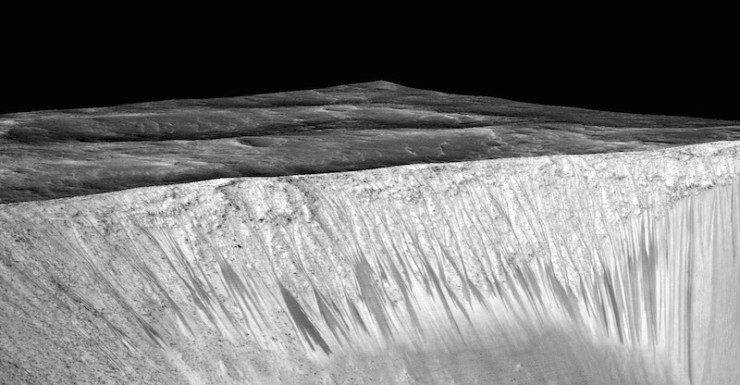After teasing a “big announcement” concerning Mars, NASA has revealed its latest findings: Using an image spectrometer, the Mars Reconnaissance Orbiter (MRO) has provided evidence that water flows intermittently on Mars today. Not just proof that it used to exist on the Red Planet, but that certain seasons produce liquid water—albeit briny, albeit intermittent, but a huge step forward in the question of whether life could be supported on Mars.
NASA’s press release describes the conditions that they believe create these findings:
Using an imaging spectrometer on MRO, researchers detected signatures of hydrated minerals on slopes where mysterious streaks are seen on the Red Planet. These darkish streaks appear to ebb and flow over time. They darken and appear to flow down steep slopes during warm seasons, and then fade in cooler seasons. They appear in several locations on Mars when temperatures are above minus 10 degrees Fahrenheit (minus 23 Celsius), and disappear at colder times.
…These downhill flows, known as recurring slope lineae (RSL), often have been described as possibly related to liquid water. The new findings of hydrated salts on the slopes point to what that relationship may be to these dark features. The hydrated salts would lower the freezing point of a liquid brine, just as salt on roads here on Earth causes ice and snow to melt more rapidly. Scientists say it’s likely a shallow subsurface flow, with enough water wicking to the surface to explain the darkening.
MRO has been examining Mars since 2006; Lujendra Ojha (from the Georgia Institute of Technology), the lead author on these published findings, first noticed the strange hydrated salts as an undergraduate student at the University of Arizona in 2010. Ojha and his co-authors identified the salts as perchlorates, which had previously been identified in the 1970s Viking missions as well as others, but this is the first time they’ve been identified from orbit.
Michael Meyer, lead scientist for NASA’s Mars Exploration Program, put this discovery in context:
“It took multiple spacecraft over several years to solve this mystery, and now we know there is liquid water on the surface of this cold, desert planet. It seems that the more we study Mars, the more we learn how life could be supported and where there are resources to support life in the future.”
Learn more and check out more images at NASA’s site!










